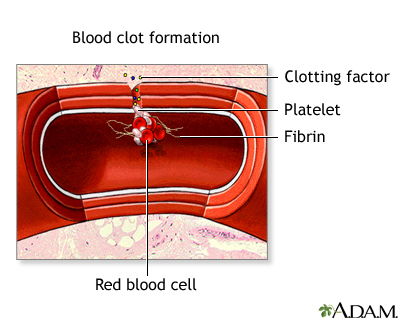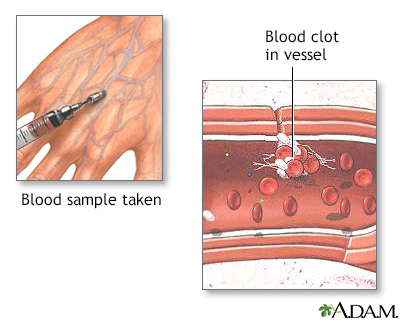Prothrombin deficiency
Definition
Prothrombin deficiency is a disorder caused by a lack of a protein in the blood called prothrombin. It leads to problems with blood clotting (coagulation). Prothrombin is also known as factor II (factor two).
Alternative Names
Hypoprothrombinemia; Factor II deficiency; Dysprothrombinemia
Causes
When you bleed, a series of reactions take place in the body that helps blood clots form. This process is called the coagulation cascade. It involves special proteins called coagulation, or clotting, factors. You may have a higher chance of excess bleeding if one or more of these factors are missing or are not functioning like they should.
Prothrombin, or factor II, is one such coagulation factor. Prothrombin deficiency runs in families (inherited) and is very rare. Both parents must have the gene to pass the disorder on to their children. A family history of a bleeding disorder can be a risk factor.
Prothrombin deficiency can also be due to another condition or use of certain medicines. This is called acquired prothrombin deficiency. It can be caused by:
- Lack of vitamin K (some babies are born with vitamin K deficiency)
- Severe liver disease
- Use of medicines that prevent clotting (anticoagulants such as warfarin)
Symptoms
Symptoms may include any of the following:
- Abnormal bleeding after childbirth
- Heavy menstrual bleeding
- Bleeding after surgery
- Bleeding after trauma
- Bruising easily
- Nosebleeds that do not stop easily
- Umbilical cord bleeding after birth
Exams and Tests
Tests that may be done include:
- Factor II assay
- Partial thromboplastin time
- Prothrombin time (PT)
- Mixing study (a special PTT test to confirm prothrombin deficiency)
Treatment
Bleeding can be controlled by getting intravenous (IV) infusions of plasma or concentrates of clotting factors. If you lack vitamin K, you can take this vitamin by mouth, through injections under the skin, or through a vein (intravenously).
If you have this bleeding disorder, be sure to:
- Tell your health care providers before you have any kind of procedure, including surgery and dental work.
- Tell your family members because they may have the same disorder but do not know it yet.
Support Groups
More information and support for people with Factor VII deficiency and their families can be found at:
- National Hemophilia Foundation -- www.hemophilia.org/community-resources
- NIH Genetic and Rare Diseases Information Center -- rarediseases.info.nih.gov/diseases/2926/prothrombin-deficiency
Outlook (Prognosis)
The outcome is good with proper treatment.
Inherited prothrombin deficiency is a lifelong condition.
The outlook for acquired prothrombin deficiency depends on the cause. If it is caused by liver disease, the outcome depends on how well your liver disease can be treated. Taking vitamin K supplements will treat vitamin K deficiency.
Possible Complications
Severe bleeding in the organs can occur.
When to Contact a Medical Professional
Get emergency treatment right away if you have unexplained or long-term blood loss, or if you cannot control the bleeding.
Prevention
There is no known prevention for inherited prothrombin deficiency. When a lack of vitamin K is the cause, using vitamin K can help.
Gallery


References
Gailani D, Wheeler AP, Neff AT. Rare coagulation factor deficiencies. In: Hoffman R, Benz EJ, Silberstein LE, et al, eds. Hematology: Basic Principles and Practice. 7th ed. Philadelphia, PA: Elsevier; 2018:chap 137.
Hall JE, Hall ME. Hemostasis and blood coagulation. In: Hall JE, Hall ME, eds. Guyton and Hall Textbook of Medical Physiology. 14th ed. Philadelphia, PA: Elsevier; 2021:chap 37.
Ragni MV. Hemorrhagic disorders: coagulation factor deficiencies. In: Goldman L, Schafer AI, eds. Goldman-Cecil Medicine. 26th ed. Philadelphia, PA: Elsevier; 2020:chap 165.